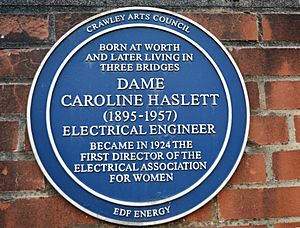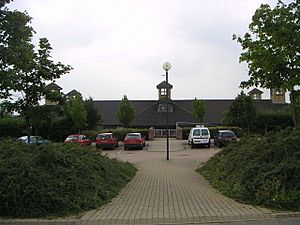Caroline Haslett facts for kids
Quick facts for kids
Caroline Haslett
|
|
|---|---|

Caroline Haslett c.1924, when she became director of the Electrical Association for Women
|
|
| Born |
Caroline Harriet Haslett
17 August 1895 Worth, Sussex, England
|
| Died | 4 January 1957 (aged 61) Bungay, Suffolk , England
|
| Nationality | English |
| Occupation | Electrical engineer; business woman; educator |
| Known for | Feminism; electrifying the home to liberate women from domestic drudgery. She was the leading professional woman of her age. |
| Title | Dame Commander of the Order of the British Empire |
Dame Caroline Harriet Haslett (born August 17, 1895 – died January 4, 1957) was an amazing English electrical engineer. She worked to bring electricity into homes and fought for women's rights. She believed that electricity could free women from endless chores. This would give them time to follow their own dreams.
Caroline Haslett was a pioneer in many ways. She helped start the Women's Engineering Society. She also founded the Electrical Association for Women (EAW). Her goal was to make life easier for women through electrical power. Back in the 1920s, most homes didn't even have electric lights. The National Grid (the UK's main electricity network) didn't exist yet.
She once said: "Electricity is making way for a higher order of women. Women set free from hard work, who have time for thinking. For self-respect. We are coming to an age when the spiritual and higher state of life will have freer development. This is only possible when women are freed from soul-destroying chores. I want every woman to have free time to learn more about the important topics of the day."
Contents
Early Life and Beginnings
Caroline Haslett was born in Worth, England. Her father worked on railways and was active in the co-operative movement. After school, she studied to be a secretary in London. She also joined the Women's Social and Political Union (WSPU), a group fighting for women's right to vote.
During World War I, she started working in a factory. This is where she learned basic engineering skills. From then on, she became a leader for women in engineering and professional fields.
A Career of Firsts
In 1919, Caroline Haslett became the first secretary of the Women's Engineering Society (WES). She also started and edited their magazine, The Woman Engineer. She continued editing it until 1932.
In 1924, she met Mabel Lucy Matthews. Mabel had an idea to make electricity popular for home use. She wanted to lighten the load of housework for women. Other groups had turned the idea down. But Caroline saw its huge potential.
She helped create the Electrical Association for Women (EAW) in 1924. She was its first director and stayed in that role until 1956. She also edited the EAW's magazine, The Electrical Age.
Caroline was part of many important groups. She was in the Women's Provisional Club for Professional and Businesswomen. She also joined the Six Point Group. This group fought for six key areas of equality for women. These included political, work, and legal rights.
Leading the Way for Women Engineers
In 1925, the Women's Engineering Society gained national attention. They held a big conference at Wembley. The Duchess of York (who later became Queen Elizabeth the Queen Mother) opened the event. Nancy, Lady Astor, the first woman in the British Parliament, chaired it. This event helped Caroline Haslett become known to more people.
She continued to be a leader in the WES. She was its president from 1940 to 1941.
International Influence and Safety
Caroline Haslett was the only woman delegate at the World Power Conference in Berlin in 1930. She represented Britain at many other power conferences too. She was incredibly active for over 20 years.
She was involved in many important organizations. She was a member of the British Institute of Management. She also served on the council of the Royal Society of Arts. She became the first woman to be made a Companion of the Institution of Electrical Engineers (IEE).
In 1932, she became the chair of the Home Safety Committee. This group worked to make homes safer. She was also the first woman vice-president of the National Safety First Association.
Wartime Contributions
During World War II, Caroline Haslett played a vital role. She was the only woman on a committee that looked at electrical rules for homes after the war. This committee helped create BS 1363, a new standard for plugs and sockets. A key part of this standard was making sure socket outlets were safe for young children. This led to the modern plugs we use today.
She also helped create the Woman Power Committee in 1940. This group aimed to protect the interests of British women during the war. They pushed for fair treatment and equal pay for women workers.
Post-War Leadership
After the war, Caroline Haslett continued her important work. She became president of the International Federation of Business and Professional Women in 1950. She was also the first woman to lead a government working group.
She represented the UK government on business trips to the US, Canada, and Scandinavia. She also helped organize conferences for women in Germany after the war.
In 1947, she achieved a major milestone. She was appointed to the British Electricity Authority (BEA). This organization was set up to run the electricity industry after it became owned by the nation. She was the first woman member of the BEA.
In her honor, the BEA named one of its ships Dame Caroline Haslett. She took a personal interest in the ship and its crew. The BEA also created the Caroline Haslett Trust. This trust provides scholarships for people in the electricity industry.
Honors and Recognition
Caroline Haslett received many awards for her work. In 1931, she was made a Commander of the Order of the British Empire. In 1947, she became a Dame Commander of the Order of the British Empire. This is a very high honor.
In 1932, she was elected a Companion of the Institution of Electrical Engineers (IEE). Her portrait was painted in 1945 by Ethel Léontine Gabain. This painting is now kept at the Imperial War Museum.
From 1950 until her death, she served as a Justice of the Peace for London.
Later Life and Legacy
Caroline Haslett retired due to poor health. She passed away on January 4, 1957, from a heart attack. In her will, she asked to be cremated using electricity.
Her memory lives on in several ways. A blue plaque honors her in Crawley, West Sussex. A road there is also named Haslett Avenue East.
Caroline Haslett Primary School in Milton Keynes is named after her. An exhibition about her life was held in Crawley in 2019.
Images for kids
See also
 In Spanish: Caroline Haslett para niños
In Spanish: Caroline Haslett para niños






